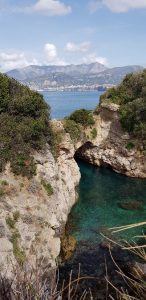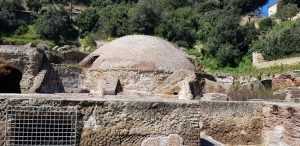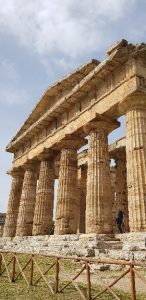Pompeii and Herculaneum study trip 2018! – by Selin Erez
A popular module that can be taken by second year students (but all year groups are welcome on the study trip component!) is the Ancient and Historical Study Places module. This year, in April, Drs Nigel Pollard and Jo Berry took students to the Bay of Naples. There the students delivered on-site presentations as part of their assessment and visited a range of ancient sites and museums, including Pompeii, Herculaneum, Paestum and Cumae. In this week’s blog post, Selin Erez reflects upon her memories of the trip.

This Easter, as part of the Ancient and Historical Study Places module, I had the opportunity to visit numerous ancient archaeological sites around the Bay of Naples. The majority of the sites were buried after the eruption of Mount Vesuvius in AD 79. It was so rewarding to be able to visit the places I had heard and read so much about in lectures. As a result of this trip, I fell in love with the Bay of Naples and I definitely want to go back again someday. During the week, we visited twelve archaeological sites, the Naples Museum, and even had time to climb Mount Vesuvius where we all enjoyed a glass of wine at the summit!
Although I enjoyed the entirety of the trip, there were some moments and sites that particularly stood out. Visiting ancient villas outside of city walls, and the opportunity to investigate how wealthy Romans lived in comparison to those living in the smaller domus type houses, was a high point. Villa A at Oplontis, where it is rumoured that Empress Poppaea resided, was particularly informative. Another favourite moment was when I reached the top of Mount Vesuvius and saw the full extent of the Bay of Naples with my own eyes for the very first time. It truly demonstrated the severity of the AD 79 eruption and how far reaching its effects were upon the surrounding towns.

Before the trip to the Bay of Naples, I was already quite intrigued by the Roman town of Baiae, due to its description as a town that is now half underwater. This created a kind of ‘Atlantis-like’ impression for me, adding a sense of mystery due to buildings and statues being submerged! Additionally, it was interesting to hear about the ancient stories of drunken behaviour in Baiae, as it had created a name for itself as a place to escape your problems in Rome. Moreover, the architectural qualities interested me too. The cement domes frequently seen on the tops of buildings in the town demonstrate the development of styles and tastes in certain areas. These cement domes predated the dome on the Roman Pantheon, challenging misconceptions that Rome led the development of certain architectural features in the ancient world.

As a part of this trip, all students were required to prepare a fifteen-minute speech on a chosen site. I chose the theme of Romanisation and the Roman Forum at Paestum. At first I was nervous about standing in front of everyone (our trip was made up of undergraduates, postgraduates, and also lecturers!), but this was easy to overcome as everyone was in the same position and we were given a lot of support from our lecturers. All of the students on the trip reassured and supported one another too. I am actually grateful for this element of the trip because it provided us all with more in-depth learning experience at each site, as each presentation was detailed and entertaining.
Overall, I thoroughly enjoyed myself on this trip and would recommend it to anyone! The sheer number of sites we were able to fit in still surprises me and I felt I was completely immersed in ancient culture all week, whilst simultaneously making lots of new friends across all year groups in our department.
